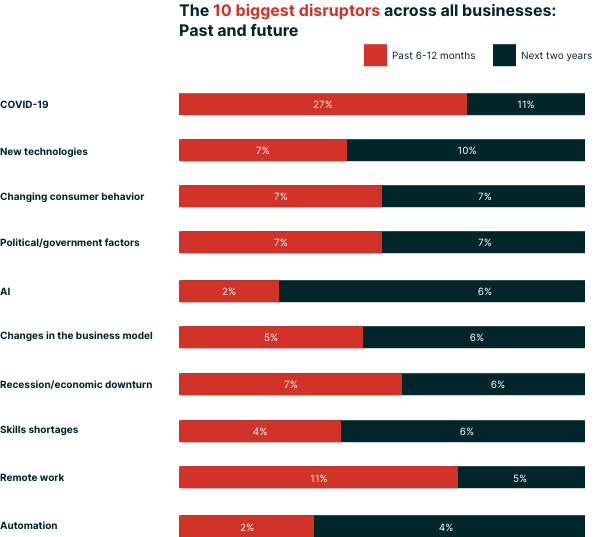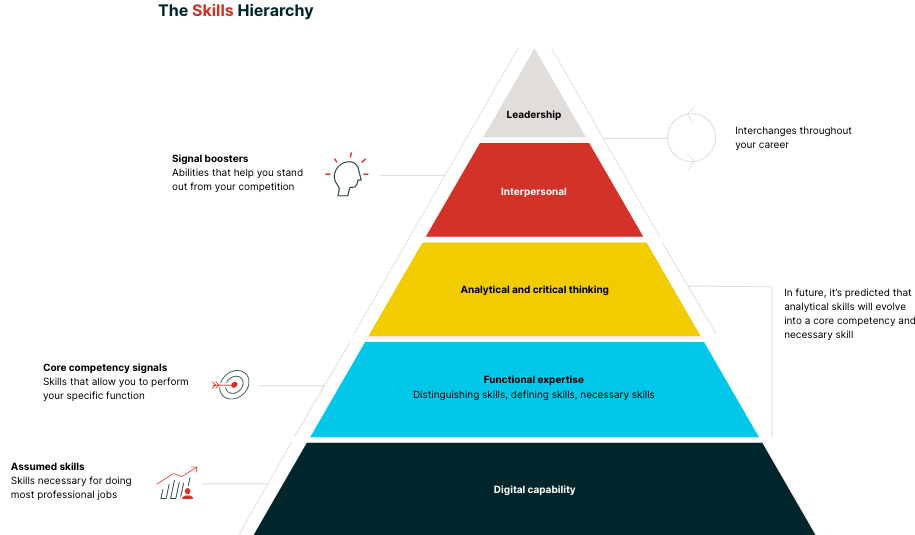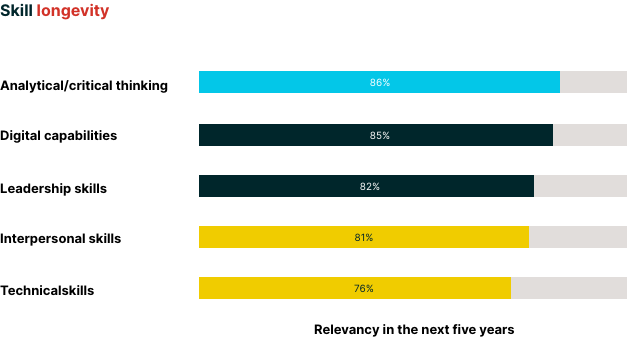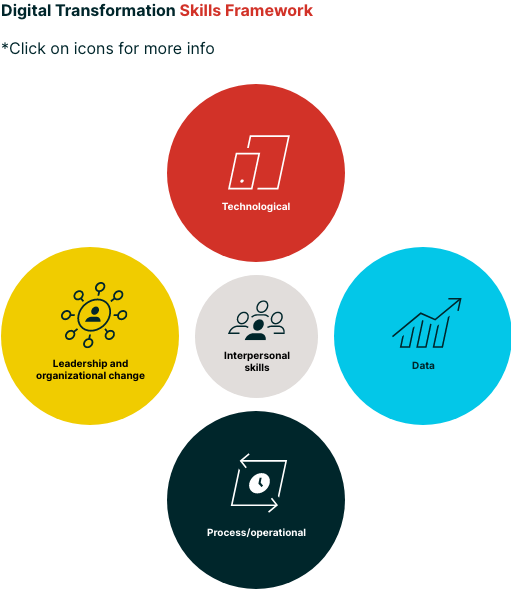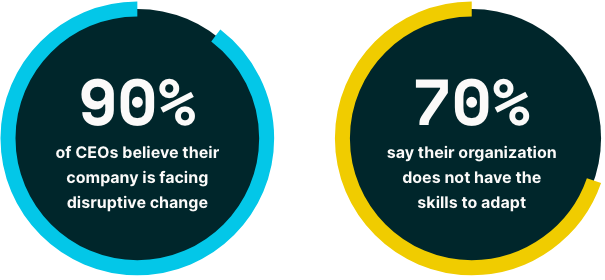edX surveyed 1,600 executives and professionals about their expectations for learning and development on the job
The arrival of advanced generative AI, and now ChatGPT, has sent a clear message to workers in nearly every sector: The AI revolution is here. Employers are turning to automation to deliver on their business goals, with C-suite executives openly embracing AI as a tool that can enhance productivity and efficiency. But effectively leveraging the power of AI requires a workforce that is skilled in using these tools.
edX’s recently released whitepaper, Navigating the Workplace in the Age of AI, shares insights from a survey of 800 executives and 800 working professionals. The survey finds that, rather than turning to post-secondary institutions to upskill, professionals are expecting their employers to deliver the training they need to meet the future demands of the workplace.
With this shift in expectations, Learning and Development (L&D) teams will face new challenges and opportunities as they work to bridge the skills gaps that exist for professional learners. How will they achieve this considerable task? This blog reviews findings from the survey, which can offer guidance to organizations managing the learning needs of their employees.
Who is responsible for learning and development?
The need to upskill is high; C-suite executives surveyed estimated that about half of the skills that exist in the workforce today won’t be relevant in just a few years. Faced with a skills gap, many workers have previously sought out education and training from institutions of higher education. However, the edX survey revealed that this mindset has shifted recently, with more than 80% of employees stating that they now see companies as the new post-secondary colleges.
C-suite executives overwhelmingly agree (93%), and are tasking L&D teams with ensuring that employees have the training they need to perform in their current roles and to excel in the next two to five years. But are they succeeding?

That answer depends on who you ask. While about half of executives believe there is a strong culture of learning in their organizations and that employees are given the time to learn, only one in five employees strongly agree. If companies want to position individual contributors for success, business leaders and L&D teams need to work together to provide more opportunities for professional learners.

L&D teams are expected to address a number of critical business needs, including performance, recruitment, and retention
According to the survey, executives believe that L&D programs should be focused on upskilling at scale (53%) and driving employee performance (50%), but about half also see it as an important strategy to keep employees engaged.

And they are right to prioritize L&D for employee engagement. Nearly 60% of employees reported that they are primarily motivated to learn at work because they enjoy challenging themselves. Other popular reasons include improving job performance (55%) and working toward a promotion or raise (46%).
Employers shouldn’t be fearful that better trained workers might leave for green pastures. Only one in 10 respondents reported upskilling in order to get a job somewhere else, and almost 80% said they were more likely to stay with their company long term if it offered better training and development.

Learning options that are popular with employees include libraries of self-paced content, online cohort learning, and face-to-face sessions. The survey found that employees in the Tech, Advertising, and Engineering sectors particularly value high-quality online learning.

Offering a range of L&D options can also be an important recruitment strategy. The best and brightest are looking to join employers that are as invested in their continuous learning and development as they are. Results of the survey indicated that Gen Z places a particular importance on professional development when selecting employers, gravitating more toward coaching and apprenticeships. Millennials, meanwhile, prefer online learning, underscoring the need for a variety of scalable learning solutions.
The challenge of providing high-quality learning at scale
As noted, there is a discrepancy between how employers and employees view the culture of learning at their organizations. Unsurprisingly, the survey found that there is a similar discrepancy regarding the perception of employee satisfaction with L&D offerings. While the C-suite believes that a significant majority (65%) of employees are “very satisfied”, in reality only one in three employees agree. Employees are more likely to be only somewhat satisfied (48%) and one in six are actively dissatisfied.

To boost satisfaction rates, companies need to look closely at their offerings to determine whether they can meet the needs of employers in better ways. The survey revealed that the most commonly offered L&D benefit today is still in-person sessions; half of the business leaders said that they offer this type of training. However, self-paced courses and cohort-based online learning are becoming increasingly popular. Online learning options are more commonly offered in the fields of consulting, finance and tech, while a number of sectors, such as advertising and engineering, remain underserved when it comes to online learning.
Is online cohort learning the scaling solution for L&D?
To answer this question, it’s important to consider what drives employee satisfaction with learning options. According to the survey, the top three requirements that employees have for L&D trainings are:
- The ability to put knowledge to use via practice exercises (27%).
- Access to new or regularly updated content (19%).
- A variety of teaching methods, with videos, readings, and more (17%).
If employees are expected to invest their time into learning, it needs to be practically relevant and as up to date as possible. These top needs can be met by quality online learning. In fact, satisfaction rates are already highest for online cohort-based courses, with 43% of the respondents saying they are “very satisfied” with this option.
With the array of online learning options available to employers, how can they find the right high-quality offering for their organizations? They must prioritize the needs of their workforces. When helping companies select the best L&D options for them, edX For Business breaks down the aims of L&D into three broad categories:
- Supporting performance: On-demand microlearning can help with more tactical and task-related upskilling.
- Building a skill: Longer-form learning that balances practical and theoretical experiences can help employees develop individual skills.
- Building a capability: Learning from academic experts and industry leaders alongside a network of fellow professionals can offer a richer educational experience that builds the capabilities needed to achieve the most critical business goals.

Employees prioritize learning over saving and, sometimes, job security
It’s undeniable that individuals are very personally motivated to learn. About 70% of employees reported actively learning between 0.5-3 hours a week.
However, the survey also found that more than 60% are using content external to their company’s L&D program to learn. Moreover, in the last 12 months, the majority of employees (57%) and executives (89%) paid for external learning content out of pocket. In fact, executives who overwhelmingly believe their L&D programs are positively impacting employee performance would also rather pay for their own L&D than use their company’s resources.

Workers at every level are acutely aware of the fact that they need to upskill themselves, and that the cost of not doing so is higher than the price tag associated with education and training. About half of employees reported that they are willing to make some kind of sacrifice to access better L&D opportunities, whether it be taking a more stressful job or a job with less time off. It’s clear that employees are personally invested and prepared to go the extra mile. The question remains: Are companies willing to match their efforts and enthusiasm, and empower L&D leaders to make a difference?

L&D programs might be meeting needs now, but are struggling with future-proofing
There is room for improvement, but employees are generally positive that they are learning from their L&D programs. Approximately 80% of respondents say that they have more or less what they need to succeed in their current roles (although only about a quarter strongly agree). However, only a third of employees are “very confident” they’ll be able to improve their skillsets and advance their career using only their employer’s L&D programs. About the same number feel they lack the skills needed to perform their roles in the future when looking just one or two years ahead.

A significant portion of the workforce also needs direction. The survey found that about a quarter of employees “don’t know where to get started” when it comes to learning new skills. This is a particularly significant problem when it comes to AI skills. Employees are feeling pressure to adapt to these new tools, but are notably more apprehensive than leadership about embracing them. L&D teams should view this as an opportunity to step in and provide the much-needed clarity on where to start and what skills to prioritize. Leveraging the AI Academy at edX For Business can help teams familiarize themselves with the tools they need and the skills that will be required to transition into new phases of work.

Bringing it all together: What are the opportunities ahead?
The findings from the survey paint a helpful picture for business and L&D leaders as they consider how to tackle the upskilling challenge. As they plan ahead, leaders must consider:
- Executives and employees see L&D as critical to business success, with many invested in lifelong learning.
- While employees are personally motivated to learn, they do expect employers to provide all the necessary training to build the skills needed for current and future roles.
- The quality of the professional development offered not only impacts performance, but can significantly influence retention, employee engagement, and recruitment efforts.
- There is a sizeable gap in perception between leaders and employees as to how well the current L&D programs are working.
- Leveraging high-quality online learning can address a number of today’s upskilling challenges, with online cohort learning yielding particularly high engagement and satisfaction rates.
L&D teams are under immense pressure to deliver results. It’s no longer sufficient for L&D to support only employees’ current performance. Professionals are apprehensive whether they have the skills needed for tomorrow’s workforce, so L&D must help them plan for the future and remain relevant in a fast-changing working world.
Although this presents a considerable challenge, it is also a huge opportunity. Businesses that recognize the importance of L&D for their organizations and invest appropriately in the right types of learning will be better positioned to navigate the obstacles of tomorrow and seize the moment with a workforce that has the right skills to do so.
Research findings are based on a survey conducted by edX and Workplace Intelligence between July 10 and July 24, 2023. In total, 1,600 full-time, U.S.-based employees completed the survey, including 800 C-suite executives and 800 knowledge workers. Respondents were invited to take part in the survey via email and were provided with a small monetary incentive for doing so.



